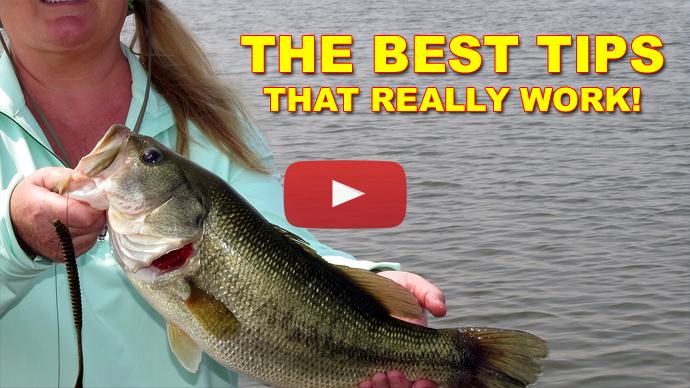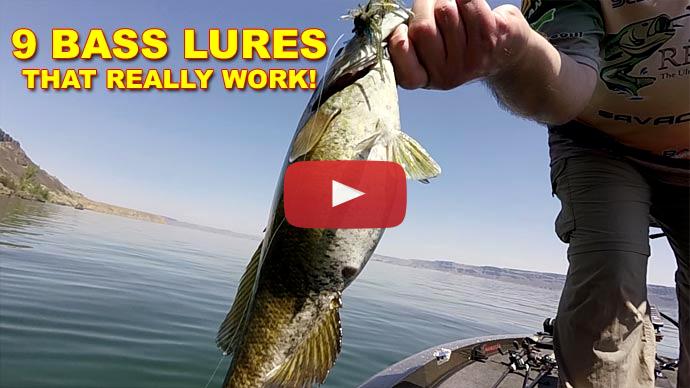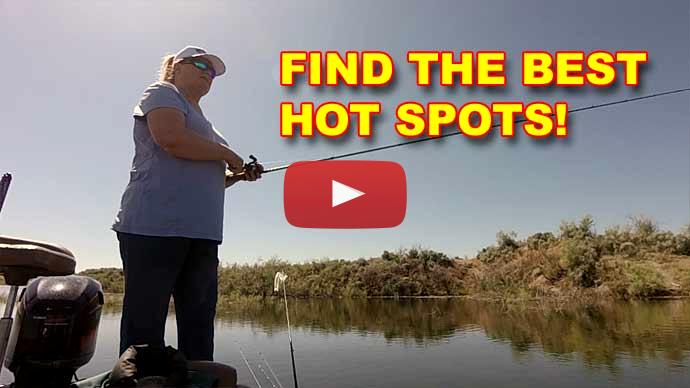Hey, guys, Michael Neal here with BassResource. I want to talk to you about spinning rod finesse tactics in the summertime. So summertime is what we're going to classify as when the fish start being post-spawn up until they start moving in for their fall feeding in the late fall and really chasing those baitfish. And when they get out there in the summertime after post-spawn, they're not always super aggressive, you know, especially on places that...like on the Tennessee River where they school up, and even up north some on the community holes, as you call them.
A lot of times you can catch those fish on big baits, moving baits, swim baits, you know, big football jigs, things like that. But even after those fish get a little bit wary, you can still get a lot of bites on finesse tactics.
And my number one for summertime when it comes to largemouth is this bait right here. It's just a Skinny Stick. It's from Big Bite. So basically it's just a five-inch cut-down version of just your traditional soft plastic stick bait. And with it being a little thinner like that, it's not as bulky of a profile. It's a little more finesse-y. It gives you a little more action. It's going to have a little bit of flutter when you're actually pulling that bait around, or if it's dropping and hitting the bottom, then just a big five-inch stick bait.
And that's what I like about it. And it comes in a bunch of different colors. This is smoke purple, so it's supernatural. You know, you've got a polluted dawn, double purple, some of your more traditional bright colors for your summertime. And those work well also. It's really a matter of personal preference. If you find the fish in your lake really like a more natural, or if they like something that really stands out and gets their attention.
But to me in the summertime, I'm going to be fishing offshore no matter where I'm at in the country the majority of the time. And that's where this rod really comes in. So it's a Denali Kovert seven-foot-six medium action rod. And I like the length of it to make those long casts.
And when you've got fish that have been pressured a lot, by now in the summertime, they have been pressured, you want to stay as far away from them as you can. You don't want to be up on top of them trying to vertically, you know, drop straight down to them or make really short casts. You want to stay as far away as you can so they don't know that you're there. At least until you catch a couple of them. And then they're going to figure it out pretty quickly most of the time. So that seven-foot-six length makes a big difference, but it's got a really soft tip to it. So it's not going to rip the fish out.
And you can use super light line with it, down, you know, if you like six. I personally prefer seven to eight-pound Sunline shooter is what I go to for on a drop shot. And with the weight, you know, somewhere between a quarter and a half, just depending on how fast I want my bait to fall and how deep I'm fishing, and what kind of cover I'm fishing around.
So if I'm fishing, you know, ledges offshore that are just 15 to 20 foot deep in the fish are positioned, they're in current, they're down on the bottom, I'm going to go heavy. I'm going to go with like a half-ounce weight just to get it down there and keep it down there where I can drag it a little bit quicker. If I'm fishing around grass or, you know, a little bit shallower fish, 10 foot and they may be suspended a little bit, that's when I'll go down to a quarter so it doesn't fly by them. They at least have a chance to bite it on the way down and keeps you out of that cover also.
And you know, a smallmouth, it's kind of the same deal. Smallmouth and spots, they're very nomadic when it comes to summertime. And they're going to be out more roaming, chasing bait, not sitting on something. The way I like to describe it is largemouth live...they may live on a hump, they may live on that brush pile, on that stump. Smallmouth and spots live around it. A largemouth likes to keep a small home base, and a smallmouth seems like if they can...as long as they know where they're at, it may be 200 yards from that object. But that's their home, but their home range is a lot bigger.
And that's why a lot of people, I think they miss the smallmouth and the spots in the summer time is because they go right back to this one spot. And sometimes they sit there and they may sit there to feed, or they may sit there to rest or stay in the shade. But they think if they're not there, then they just totally left the area.
But that's all a lot of times totally the opposite. They're just swimming around looking for bait, looking for whatever they do. They're just very nomadic and that's the big difference between the smallmouth and the largemouth. Smallmouth, you could go with different shapes, like your SoMollys, your baitfish presentations, things like that. But as a general rule all around the Skinny Stick.
And one thing I will do with it sometimes, especially if I'm fishing suspended fish, typically I nose hook it, but sometimes, for whatever reason, you tend to get bigger bites if you'll wacky rig it. And that's just something a lot of people don't do on a drop shot is wacky rig a worm.
You know everybody likes to Texas rig it to be completely weedless, or just nose hook it like I had it here on this Gamakatsu G Finesse drop shot hook. Just a size number one. That's a good all-around size for no matter what bait you're throwing. If it is a Skinny Stick, if it's a SoMolly, anything. And if you need to Texas rig, if you're around a lot of cover, or if you prefer to like take a SoMolly and thread it up on there, the G Finesse worm hook, light wire worm hook with a 10 keeper is a great option for that. But general rule, I like to keep my hook small and keep the fish from seeing it. So that's the setup for the drop shot.
Second off, we've got the shaky head. In the summertime, a lot of those fish are positioned in current. They're on the bottom. With the drop shot, you can vary how far your bait is off the bottom just by changing how long your leader is between your weight and your hook. The shaky head is just going to be a bait to really fish slowly on the bottom. And a lot of the times earlier in the year, later in the year, I don't do the whole shake to the shaky head. But in the summertime, I want to keep that bait really in one spot and just fish it really slowly and shake it along.
And a lot of people think with a shaky head, you need to keep your line tight when you're doing that shake. But to me, if you're keeping it tight, you're actually bringing it to you the whole time. So if you'll cast it out there and just shake your slack, that's when that bait's really going to come up with the tail up off the bottom. And you're going to have your best action and best results to keep that bait in one place in the strike zone longer for those lethargic bass.
And this right here is an eighth-ounce Limit Maker head. I like an 1/8 to a 3/16. So I still don't want to go real heavy because if I go heavier, I want to move it faster. You know, the drop shot, I like to have it down there on the bottom, but your bait's up off the bottom a little bit. So there's still wanting to be in a little bit more of a feeding mood than a shaky head. And when the shaky head's on the bottom, you have to fish it slow, or you're just not going to get that many bites compared to really dragging it like the speed of a Carolina rig or things like that.
For the rod setup, this is the same one that I use pretty much year-round. And it's the Denali N3. It's a seven-foot medium action. It's just a great all around, whether you're fishing offshore, on the bank. This is just, it's got a little bit more backbone than the Kovert does. And I like that for a shaky head, the hooks are typically a little bit bigger diameter. So you need a little bit more power to get those fish in. You can see that the bend of the rod does not go nearly as far back as it does. Where with a drop shot rod, I like it to be parabolic, you know, bend pretty close to halfway back in the rod. But I like a little bit faster action with the shaky head. And that's just to have a little more power to get that hook through the plastic and into the fish's mouth out there.
And it's not just something that in the summertime, you're always going to be fishing offshore, or you're going to be fishing deep, you know, skipping a shaky head under boat docks or anywhere with shade on shallower places. That's a great option as well.
If you've got, you know, summertime rains where you might have the lake stained up for a little bit, these finesse options are still really great. Just change up your colors a little bit, go a little bit darker, you know, maybe go to a black or a scuppernong, which is just a solid brown or a Junebug even if you get really, really dark conditions. But it's just a great all-around setup for summertime as well.
And again, Sunline SX1 to 7 to 8 pound Sunline Shooter. Sunline Sniper is great as well. A lot of guys use that. Shooter is just where I have most of my confidence in.
And spinning rods are what I do when I need to get a bite. It doesn't matter if it's, you know, down south in the dog days of summer, or if you're up north in June, July chasing around smallmouth. It's just a great way to get bites.
A lot of people knock on it because they don't think it catches big fish. But as you're seeing more and more, especially in the tournament world, the more pressure these places get, the more people are relying on spinning rods, the more they're going back to light line, finesse tactics like the drop shot and the shaky head, not only to get bites, but to catch those tournament-caliber winning fish too.
So it's just a great presentation. Again, dog days of summer, it's oftentimes you want to fish a lot slower than you had to. People think the hotter it is, the faster you want to fish. But that can be the exact opposite when it comes to fish that have been messed with a lot, or that are just super lethargic and really don't want to eat a whole lot that time of year.
So make sure you check out these summertime tips for finesse gear from BassResource as well as anything else you need in the bass fishing world.



